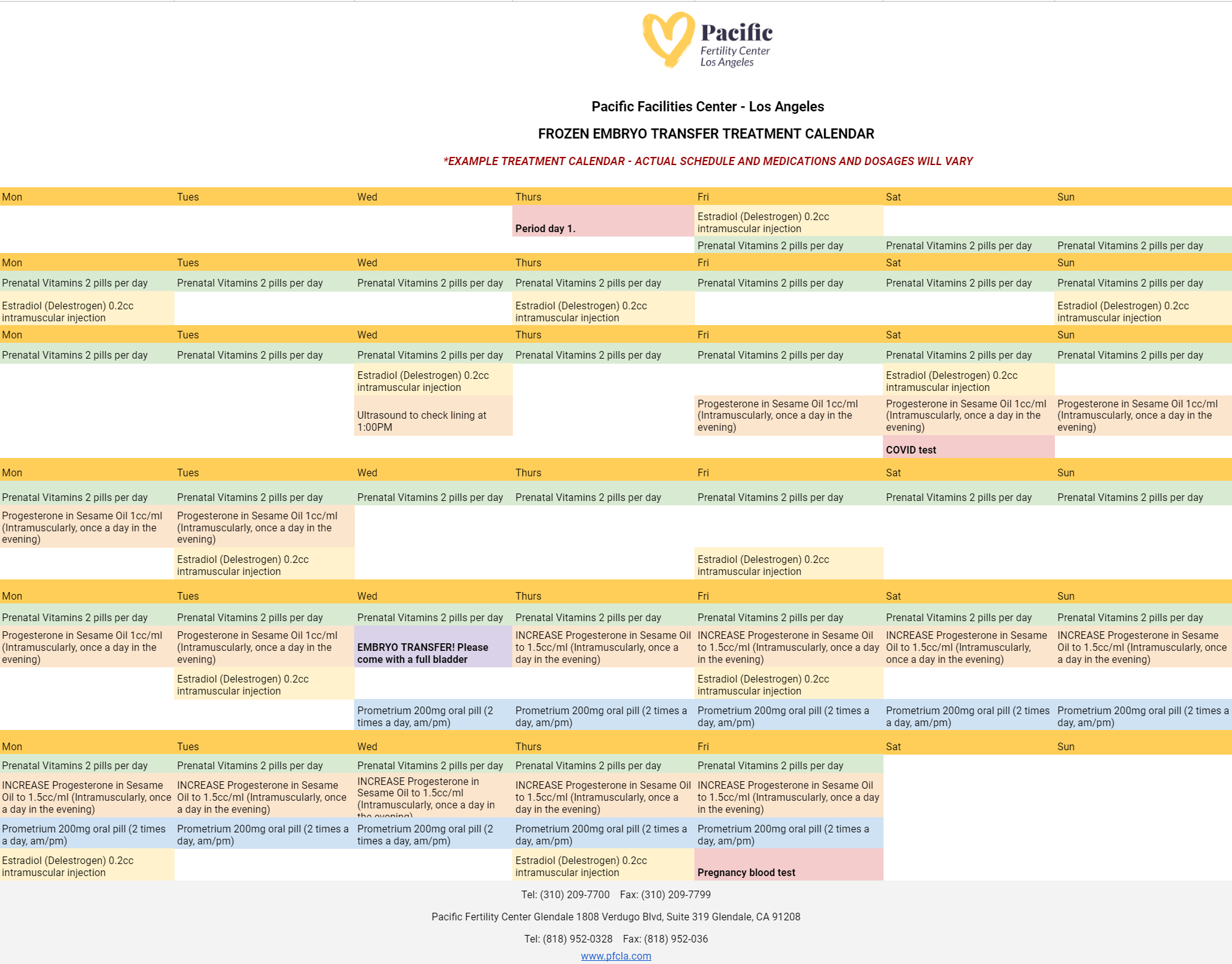Embarking on the journey of a Frozen Embryo Transfer (FET) can be both exciting and overwhelming. In this article, we’ll provide a comprehensive overview of FET including definitions, timelines, and useful tips to help you prepare.
Whether you're new to In Vitro Fertilization (IVF) or considering FET as your next step, this guide aims to support and inform you throughout your fertility journey. You'll learn what FET is and how it works, understand the typical timeline from preparation to post-transfer, and discover practical advice on diet, scheduling, and lifestyle considerations to maximize your chances of success.
What is a Frozen Embryo Transfer (FET)?
A Frozen Embryo Transfer (FET) is a procedure used in assisted reproductive technology (ART) where a cryopreserved embryo created in a previous IVF cycle is thawed and transferred into a surrogate or intended parent’s uterus. This process can be an effective alternative to a fresh embryo transfer and offers flexibility in timing for patients.
Why Choose a Frozen Embryo Transfer?
Choosing a Frozen Embryo Transfer offers several advantages compared to other embryo transfers:
- Flexible Timing: Unlike fresh transfers that must occur immediately after egg retrieval, FET allows for the scheduling of the transfer at a time that is most convenient and optimal for the patient.
- Success Rates : Studies have shown that FET can have success rates comparable to or even higher than fresh embryo transfers, partly due to the ability to better prepare the uterine environment.
- Reduced Ovarian Stimulation: Patients do not need to undergo ovarian stimulation again, reducing the physical and emotional burden of additional hormone treatments.
- Genetic Testing: Embryos can be tested for genetic abnormalities before freezing, allowing for the selection of the genetically healthiest embryos for transfer.
Hormonal Support and Natural FET-IVF Cycles
There are two kinds of FET-IVF cycles: Hormonal support cycles and natural cycles.
Hormonally supported FET cycles are more popular with couples because estrogen and progesterone are administered to mimic the body’s cycle and thicken your endometrium. Clinics and labs typically prefer this FET cycle because the day of the frozen embryo transfer is easy to control and hormonal support is available for ovulatory problems.
In Natural FET-IVF cycles, the timing of your frozen embryo transfer is determined when you ovulate naturally. However, an hCG shot is typically given to ensure ovulation occurs and progesterone will be used for luteal phase support after ovulation and transfer.
IVF Frozen Embryo Transfer Timelines
Because a female body produces progesterone when ovulating, the endometrial lining develops at the optimal rate to nurture the fertilized eggs. As with most things Assisted Reproductive Technology (ART), timing is everything.
Depending on the individualized treatment plan, most patients can expect endometrium preparation to last 2-4 weeks. Once the patient has reached an optimal stage in their cycle, the frozen embryo transfer will soon follow. Specific dates vary from patient to patient, your fertility specialist should provide you with a detailed treatment calendar of what to expect.
Here's an example of PFCLA's frozen embryo transfer treatment calendar, which intended mothers or surrogates will undergo as they prepare for the frozen embryo transfer:

View full-size example treatment calendar
13 Frozen Embryo Transfer Tips [2024]
Navigating through a frozen embryo transfer cycle may come with its fair share of uncertainties and stress. However, by delving deep into what lies ahead and strategizing for optimal outcomes, you can kickstart your journey with confidence and positivity.
When preparing for your IVF frozen embryo transfer, use these tricks and tips before your procedure to increase your chances of a successful transfer:
1. Organize and Take Medications On Time
You’ll be given progesterone and other supplemental fertility medications to prepare your uterus and other hormonal functions for your Frozen Embryo Transfer. Make sure you have adequate levels of medications and you understand how to take them.

If your doctor recommends bed rest, it’s a good idea to move everything you’ll need within reach, especially your fertility medications. Try to plan out what medications you’ll be taking each day, and make sure that you can access everything your doctors prescribed without serious movement. This will also help make sure you’re not missing anything critical before the procedure, and you can feel confident you’re doing everything you need to do.
2. Consider Your Treatment Calendar
When planning for a Frozen Embryo Transfer, it's crucial to consider your treatment calendar to ensure the process integrates smoothly with your daily life. By thoughtfully scheduling your hormone treatments, monitoring appointments, and the embryo transfer itself, you can better manage your lifestyle, including work commitments, social outings, and personal appointments.
This proactive approach helps reduce stress and allows you to maintain a sense of normalcy during the treatment. Balancing your calendar ensures you are physically and emotionally prepared for each step, boosting the chances of a positive experience.
3. Stock Up on Entertainment
Whether you like to read, watch TV, or listen to music, keeping yourself entertained throughout the preparation for your Frozen Embryo Transfer is important for several reasons. First, it helps take your mind off the potentially nerve-wracking experience, especially for those undergoing an embryo transfer for the first time. Secondly, staying entertained during periods of bed rest provides an opportunity to focus solely on taking care of yourself.
In our fast-paced world where being busy is often promoted, disconnecting and immersing yourself in something mindful can leave you feeling rejuvenated. Additionally, incorporating meditation into your routine can further enhance your sense of well-being. Remember, you can't fill from an empty cup—self-appreciation and taking time for yourself are crucial to avoiding burnout and maintaining a positive mindset during your FET journey.
4. Purchase Warm Socks
In traditional Chinese medicine, it is believed that a "cold" uterus, characterized by poor blood flow and circulation, can contribute to infertility. While wearing warm socks may seem like a simple gesture, it is a common IVF superstition followed by many patients.
Slip-on shoes paired with cozy socks are often recommended for the day of your embryo transfer to ensure a smooth procedure. Not only will this help keep your feet warm (pun intended ;)) throughout the process, but it will also promote overall body warmth and comfort during this crucial time.
You can even purchase socks on Etsy and Amazon for your frozen embryo transfer, such as these:

5. Get Plenty of Sleep Before (And After) the Transfer
Ironically enough, being on bed rest can make getting a good night’s rest harder. Sleep and fertility are closely connected, so it’s critical to get enough sleep to support your IVF cycle. Research has found that women getting less than seven hours of sleep are 15% less likely to get pregnant than women who got seven to eight hours. If you’re having trouble falling asleep, you can take melatonin to naturally regulate your sleep schedule.
When sleeping before your embryo transfer, try to:
- Keep your bedroom between 60 and 67 degrees Fahrenheit
- Diffuse lavender in your bedroom or bathroom
- Avoid caffeine four to six hours before you go to sleep
- Stop eating two to three hours before you go to sleep
- Listen to relaxing music
- Limit blue light and screen time at least 30 minutes before bed
- Stretch gently and loosen your muscles before sleeping
6. Avoid Extreme Temperatures Against Your Abdomen and Uterus.
Make sure to have a laptop tray or a heat-blocking material readily available to protect your body from the heat generated by your laptop. It is essential to keep external extreme heat away from your abdomen and uterus to enhance the success of the Frozen Embryo Transfer procedure.
However, this rule doesn’t just apply to technology -- it’s not a good idea to visit saunas, hot tubs, or other high-heat activities because these external agents can impact or inhibit your chances of a successful embryo transfer and pregnancy at the end of your IVF cycle.
7. Prepare and Eat IVF-FET Safe Meals
Many fertility specialists suggest eating a high-fat, low-carb diet to reduce inflammation throughout the body, G.I. tract and reproductive system. This diet also aids hormone function because many female hormones are made from cholesterol, which derives from fats. It’s also important to consume an antioxidant-rich diet before your embryo transfer, so fresh produce and fruit will be critical here.
Foods To Eat Before Your Embryo Transfer
In general, reproductive endocrinologists recommend warmer foods with high concentrations of omega-3 fatty acids. As you prepare for your Frozen Embryo Transfer, eat foods like:
- Warm soups
- Whole grains like quinoa, farro, and whole-grain pasta
- Legumes like beans, lentils and chickpeas
- Healthy fats like avocado oil, extra-virgin olive oil, walnuts, and seeds
- Lean proteins like fish and chicken (look for low-mercury fish)
- Fresh fruits and veggies (Berries, Pineapple)
- Water with lemon
Foods to AVOID Before Your Frozen Embryo Transfer
Cold foods are not embryo-transfer friendly, so try to avoid:
- Cold beverages like smoothies and sodas
- Sugar
- Red meat products
- Highly processed foods
- Salt -- season with herbs and spices instead
- Coffee and tea
8. Avoid Endocrine-Disrupting Chemicals (EDC)
During the Frozen Embryo Transfer process, it’s important to avoid items made with endocrine-disrupting chemicals (EDCs). EDCs interfere with your hormones, reproductive health and prenatal development, and are also generally harmful to your overall wellness.
Some chemicals classified as EDCs found in everyday household products include Formaldehyde, Parabens, Benzophenone, Triclosan, BPAs, Phthalates, and Dioxins. The median serum conjugated BPA concentrations measured during the missed menstrual cycle were significantly higher in women who had miscarriages than in those who had live births. To limit disruptions with the embryo transfer and IVF process, try to remove all strong chemicals and scented products.
Products to remove include:
- Nail polish
- Plastics (make sure you're drinking water from a BPA-free water bottle)
- Nonstick cooking tools
- Cosmetics with fragrance
- Soaps and moisturizers with fragrance
- Meat and dairy
- Stain-resistant materials
Talk to your fertility doctor about any other chemicals or toxins you might be exposed to, and how to replace or remove them around your frozen embryo transfer.
9. Plan Logistics Before Your Transfer
The last thing anyone wants to do before their embryo transfer is to sit in traffic and run behind schedule. Before your embryo transfer, ask your fertility doctor and IVF clinic for important logistical information for your FET-IVF procedure, such as:
- What you can bring to the appointment?
- How long you can expect to be at the clinic?
- What time you should arrive?
- What you’ll wear (try to avoid tight pants and remember socks!)?
- Who can go with you?
- How long after the frozen embryo transfer you'll need to wait?
Doing this will help mitigate stress, ensure everything goes smoothly, and helps you feel confident and prepared going into this exciting procedure!
10. Pack a Bag The Night Before
The night before your frozen embryo transfer, make sure you plan for the next day and pack your bag with anything you might need -- but remember not to over-exert yourself!
As you pack a bag for your embryo transfer procedure, make sure you include:
- Water
- Warm socks
- Comfortable clothes
- A camera
- Books or a journal
- Earbuds or headphones
11. Come To Your Embryo Transfer With a Full Bladder
Follow your fertility specialist’s instructions for drinking water beforehand, or you might be waiting until your bladder is full and ready.
This helps change the angle of the uterus and makes the transfer easier, allowing your doctor to see the catheter clearly with a trans-abdominal ultrasound to achieve the best placement of your embryo during transfer.
12. Avoid Sexual Intercourse After the Transfer
Research has shown that sexual intercourse can trigger uterine contractions and disrupt the embryo transferring into your uterus. Because of this, give yourself (and your pelvic) rest after the embryo transfer. Don't worry - this is only temporary and your fertility doctor can give you personalized guidance on when you can begin having sex again.
Research has also shown intercourse one night before FET procedures may improve pregnancy rates. Consult with your doctor and follow their recommendations for your personalized treatment plan.
13. Keep Taking Fertility Medications After the Transfer
After completing the embryo transfer procedure, it is essential to continue prioritizing your well-being to increase the chances of a successful pregnancy. Maintain this level of care not only throughout the IVF process but also in the future, ensuring the best outcome for both yourself and your potential family.
Remember to keep taking prescribed fertility medications (typically progesterone and estrogen), staying away from sex, and taking a folic acid supplement (if you haven't already). This will prevent neural tube defects and has been linked to lower risk of congenital heart defects in babies.
Frozen Embryo Transfer Success Rates
Frozen Embryo Transfers have become a popular choice in assisted reproductive technology, and for good reason. Success rates for FET have steadily increased over the years, making it a viable option for many patients seeking to conceive. For patients 35 or younger, there is a 60% pregnancy rate per embryo transfer, whereas women over the age of 40 have a 20% pregnancy rate per embryo transfer.
Several factors can influence the success rates of FET, including:
- Age
- Embryo Quality
- Endometrial Preparation
- Cryopreservation Techniques
Ask Your Reproductive Endocrinologist About How to Prepare for Your FET-IVF
If you’re considering parenthood, researching your fertility options, or simply looking into Assisted Reproductive Technology such as IVF or surrogacy, know every patient’s path toward pregnancy will look different.
Parenthood is a universal blessing, and everyone deserves the opportunity to bring a new family member into this world. Pacific Fertility Center of Los Angeles is a top IVF clinic and has been bringing babies into the world since 1991, supporting patients in over 75 countries and setting standards of transparency and accountability across the ART community for 30 years.
From financing options to procedure explanations, the fertility specialists at Pacific Fertility Center Los Angeles would be happy to answer any further questions you may have regarding your embryo transfer process. Contact us today to get started.
Note: This is not intended to be a substitute for professional medical advice, diagnosis or treatment. Information provided is for general educational purposes only and is subject to change without notice. Speak to your doctor directly with any questions you may have regarding a medical condition. Any information contained herein does not replace any care plan as determined by a physician.
You May Also Like
These Stories on In-Vitro Fertilization


.png)

